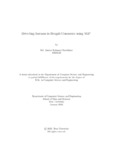| dc.contributor.advisor | Shakil, Mr. Arif | |
| dc.contributor.author | Chowdhury, Md. Jamiur Rahman | |
| dc.date.accessioned | 2024-01-09T05:26:55Z | |
| dc.date.available | 2024-01-09T05:26:55Z | |
| dc.date.copyright | 2023 | |
| dc.date.issued | 2023-01 | |
| dc.identifier.other | ID: 18101448 | |
| dc.identifier.uri | http://hdl.handle.net/10361/22082 | |
| dc.description | This thesis is submitted in partial fulfillment of the requirements for the degree of Bachelor of Science in Computer Science and Engineering, 2023. | en_US |
| dc.description | Cataloged from PDF version of thesis. | |
| dc.description | Includes bibliographical references (pages 31-33). | |
| dc.description.abstract | Natural Language Processing (NLP) is a subset of Machine Learning which resides
at the intersection of Linguistics and Computer Science. It deals with the capability
of computers to learn and work with human languages. With the emergence of social
media platforms, modern-day communication is being digitalized more than ever.
To keep up with this rapid flow of development, the advancement of automated
text processing and artificial language interpretation has become necessary. These
concerns have given birth to a domain called Sentiment Analysis where blocks of
text are processed to extract prominent sentiments that are prevalent within them.
These sentiments can be happiness, sadness, anger, disgust, etc. Over the past few
years, similar studies have garnered the attention of a vast number of computer
scientists and linguists but as the study progresses and expands in the form of lan guages, concentrations, and contexts more and more challenges have started to show
up. One of these challenges is the interpretation of figurative language. Figurative
language refers to the structure of speech where the actual meaning defers from
the literal meaning. The best example of this is Sarcasm which is a sort of figu rative language used with an intention of mockery or humor. Detecting sarcasm
is considered to be one of the most challenging tasks in the domain of NLP due
to the figurative structure and creative nature of sarcastic texts and the lack of
relevant data on the internet. Determining sarcasm can often be difficult for even
human beings as one has to have a strong understanding of the context to detect
sarcasm. However, many studies have achieved respectable results by following the
context unaware unimodal methods using classical Machine Learning, Deep and Hy brid Neural Networks. Motivated by such research, the objective of this paper is to
take a step toward detecting sarcasm in the Bengali Language domain using Sup port Vector Machine (SVM), Cogniinsight(Word2Vec), and Bidirectional Encoder
Representations from Transformers (BERT) on a novel dataset. To the best of my
knowledge, this will be the first-ever initiative taken toward detecting sarcasm in
Bengali Language using BERT. | en_US |
| dc.description.statementofresponsibility | Md. Jamiur Rahman Chowdhury | |
| dc.format.extent | 33 pages | |
| dc.language.iso | en | en_US |
| dc.publisher | Brac University | en_US |
| dc.rights | Brac University theses are protected by copyright. They may be viewed from this source for any purpose, but reproduction or distribution in any format is prohibited without written permission. | |
| dc.subject | Natural language processing | en_US |
| dc.subject | Sentiment analysis | en_US |
| dc.subject | Machine learning | en_US |
| dc.subject | Support vector machines | en_US |
| dc.subject | Word2vec | en_US |
| dc.subject | Bert | en_US |
| dc.subject.lcsh | Computational linguistics. | |
| dc.subject.lcsh | Natural language processing (Computer science) | |
| dc.title | Detecting sarcasm in Bengali comments using NLP | en_US |
| dc.type | Thesis | en_US |
| dc.contributor.department | Department of Computer Science and Engineering, Brac University | |
| dc.description.degree | B.Sc. in Computer Science and Engineering | |

